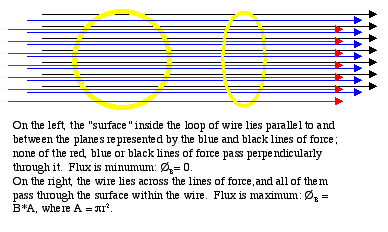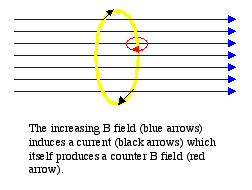
Physics
Chapter 21: 1-5

Web Lecture
Changing Magnetic Fields and Electrical Current: Induction
Introduction
Again: here is a little piece of iron which is not magnetized. It will not, at present, take up any one of these nails; but I will take a piece of wire and coil it round the iron (the wire being covered with cotton in every part it does not touch the iron), so that the current must go round in this spiral coil; I am, in fact, preparing an electro-magnet (we are obliged to use such terms to express our meaning, because it is a magnet made by electricity -- because we produce by the force of electricity a magnet of far greater power that a permanent steel one). It is now completed, and I will repeat the experiment which you saw the other day, of building up a bridge of nails: the contact is now made and the current is going through; it is now a powerful magnet; here are the iron nails which we had the other day, and now I have brought this magnet near them they are clinging so hard that I can hardly move them with my hand.
— Michael Faraday, Lecture VI on the Correlation of the Physical Forces, from the series The Forces of Matter, Delivered before a Juvenile Auditory at the Royal Institution of Great Britain during the Christmas Holidays of 1859-60. Faraday begin the lectures for juvenile audiences in 1825, allowing only those younger than 13 to sit in the front seven rows of the hall so they could easily view his live demonstrations (he was the original "Mr. Wizard"). He either gave the lectures or sponsored them until his retirement in 1861. The Royal Institute has continued presenting the "Christmas Lectures" each year since, interrupted only during the period from 1939 to 1942 when London was actively undergoing bombardment. Check out the history of the lectures and even view recent ones recorded over the last three decades at The Royal Institution: Christmas Lectures.
Outline
Remember in reading this that "emf" is not a force -- it is the potential difference resulting in current, measured in volts, not Newtons.
Electromagnetic Induction
You recall from our previous work that Ɛ is the electrical energy generated by a battery or generator; it is not really a force at all. It is equivalent to voltage, as we have seen from the case where the voltage across the terminals in a battery is equal to the Ɛ of the battery less the internal resistance r of the battery times current: Vab = Ɛ - Ir.
Induced emf
Such an emf can also be induced by moving a magnet near a conductor. Current will be produced in the conducting wire, and can be measured with a voltmeter. Michael Faraday first realized that if you then had the ability to turn a large magnet surrounded by coils of electric wire, you could then generate a constant source of electrical current.
We have now established another criteria for our list of the characteristics of matter:
- All matter has mass, and therefore generates a gravitational field whose strength is proportional to the amount of mass in the object, and whose direction is always attractive (pulling other masses toward itself).
- Some matter has charge; any object with non-zero total charge generates an electrical field whose strength is proportional to the amount of charge in the object, and whose direction depends on the type of charge.
- Moving charges generate a magnetic field whose strength is proportional to the amount of moving charge and whose direction depends on the direction and type of moving charge.
- Moving magnetic objects generate an electrical field whose strength is proportional to the strength of the magnet and whose direction depends on the orientation of the magnet and the direction of its motion.
Now, if we also recall that "motion" is relative, depending on your frame of reference, then we can see that a moving wire in a static magnetic field will experience current induction, as well a static wire in a changing magnetic field. In other words, it doesn't matter how we change the magnetic field: as long as the wire experiences that change somehow, current will flow in the wire.
Faraday's Law of Induction: The Concept of Flux
Faraday was not a great mathematician. He introduced the concept of the electrical field with few lines for a weak field and many lines for a large field as a way of keeping track of the magnitude of a field visually, rather than numerically. The stronger the field is, the more "lines of force" it has packed into a given area or passing through a given volume.
As an extension of this method of conceptualizing electrical and magnetic force, we can also look at the number of lines of force passing perpendicularly through a given area or surface in space. This "flow" of electric field through the surface is called flux, and we use the Greek letter phi Φ for it. Since the flow has to be perpendicular to the surface, we have another example of the vector dot-product, ΦB = B ⊥ A = B A cos θ, This means that we have to determine what the vector component of the magnetic field is perpendicular to the surface in question—we can't just take the magnitude of the field.

At θ = 0, cos θ = 0, so when B is parallel to A, the field simply does not pass through the enclosed area within the wire. At θ= 90, cos θ = 1, and all of the field passes through the enclosed area. If the field strikes the enclosed area's plane obliquely, then the field flux is equal to only the perpendicular component of the magnetic field vector, or B * cos θ.
Now, an emf arises and causes current to flow in the wire only if the magnetic flux changes—which means either B, A, or cos θ change (or some combination). The amount of current will be proportional to the change of flux on a per loop bases, so if we add loops to the same wire, we will increase the current flowing in the loop. If we have N loops, the current increases N times.
Faraday's law of induction summarizes these findings:
This ultimately gives rise to a current I in the wire where I = emf/R if R is the resistance in the wire.
So, if we vary B by changing how the magnetic field is generated, we will get an emf. If we vary A by changing the size of the loop somehow, we will get an emf. And if we change θ —that is, change the orientation of the loop to the field —we will get an emf.
Lenz' law
Now, what should be springing immediately to mind is the question Which direction does the current flow? and the realization that the current in the wire will produce a magnetic field of its own, with a magnitude B = µ0 I / 2&Mac185; r at some point r distant from the wire. Lenz discovered that this secondary magnetic field always opposes the original change in flux, as if some kind of universal conservation law to reduce changes and maintain the status quo was in effect. And this is exactly what is happening: the law of the conservation of energy effectively prohibits the induced current to create a field that would amplify the original change. Such a situation would result in an infinite increase in the magnetic field, and the generation of infinite power.
So, if an increasing magnetic field flows from left to right through a loop perpendicular to this page, then the current induced in the loop must itself generate a field that will decrease this magnetic field by flowing from right to left through the center of the loop. Using the right hand rule, we see that this induced current must flow into the page at the top of our loop and out of the page at the bottom.

EMF in a moving conductor
Practically, changing the orientation of the loop is often the easiest: we just rotate the loop in a constant field. Because the flux is changing, we get an emf, and current in the loop. But another possibility is to move a loop perpendicular to the field in and out of the field. In order to figure out what is happening here, we have to look at the changing area A through which the field is passing. For a square loop with area A = length * width w, we consider the width changing as the loop moves. The width w at any point depends on the velocity v of the loop along the w direction and the amount of time Δt that has passed. This means
Since the field is perpendicular to the area in question, cos θ = cos 90° = 1.
Substituting into the expression for emf, we see: In other words, the emf giving rise to current comes from field of magnitude B and depends only on the height l of the loop and the rate at which it is passing through the field.
Now we can make another simple equation. Since we know that electrons in our loop are moving under compulsion a force F, we must assume that there is a an electric field E in the conductor supplying that force. We know that the electric field can be measured as F/q, where q is the charge. Since this force arises from the magnetic field, however, F is determined by F = q v B sin θ, where q is the charge on the electron, v is its velocity, and B*sin θ is the force of B in the direction of v providing the impetus of motion. We now have
Practice with the Concepts
Discussion Points
- If an aluminum sheet is held between the poles of a large bar magnet, it requires some force to pull it out of the magnetic field even though the sheet is not ferromagnetic and does not touch the pole faces. Why?
- In an LRC circuit, can the rms voltage across (a) an inductor, (b) a capacitor, be greater than the rms voltage of the ac source? If so, why?
© 2005 - 2024 This course is offered through Scholars Online, a non-profit organization supporting classical Christian education through online courses. Permission to copy course content (lessons and labs) for personal study is granted to students currently or formerly enrolled in the course through Scholars Online. Reproduction for any other purpose, without the express written consent of the author, is prohibited.